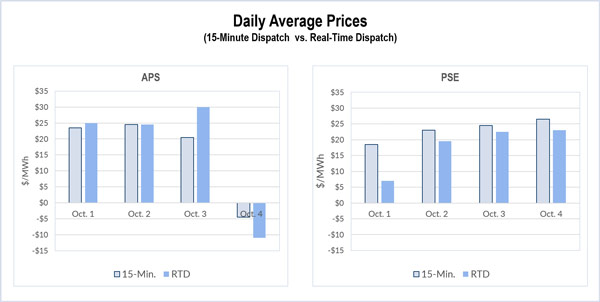By Robert Mullin
The entry of Arizona Public Service and Puget Sound Energy into the Western Energy Imbalance Market was largely “uneventful,” according to a CAISO official who helped lead the effort to integrate the two utilities into the region’s only real-time market.
“I’ve been through three sets of transitions, and I would say that each one is getting smoother,” Mark Rothleder, the ISO’s vice president of market quality and renewable integration, said during an Oct. 5 meeting of the EIM’s governing body.
Still, Rothleder noted that it took a “huge amount” of work on the part of CAISO to guide the Oct. 1 rollout, which required about 30 staff to be present at the ISO’s Folsom, Calif., headquarters while others joined APS and PSE at their operations sites.
“We found that the APS and PSE teams were very well prepared,” Rothleder said.
APS brought on 16 new hires, created four new operations and trading desks, and undertook 9,000 hours of training related to the EIM, said Justin Thompson, the utility’s director of resource operations and trading. Utility staff had been testing systems since late winter.
“My recommendation to our execs was that you need 20 months to execute this,” Thompson said. “We shoehorned it in 15 to 16 months, and I wouldn’t recommend that for anybody.”
Four days into the transition, Rothleder said that it was “not unexpected” that the ISO had observed price volatility. Staff are still reviewing the issue to determine whether it reflects actual system conditions or stems from a data anomaly or software problem in need of correction.
Delving into the operational underpinnings of the EIM, Rothleder explained that each balancing authority area (BAA) participating in the EIM needs to pass two tests heading into every hour.
The first: A BAA must be balanced between generation and load in order to match its forecast.
The second: It must demonstrate enough ramping capability or resource flexibility to meet expected variability within the hour.
“These two tests are an indication that they’re coming into the system sufficiently resourced without leaning on other parts of the system,” Rothleder said.
During the first four days of participation in the EIM, APS and PSE passed the balance test 95.8% and 100% of the time, respectively. Both utilities have so far rated 100% on the flexible ramp test.
“These are very good results — and don’t take 95.8% as an indication that anything’s wrong,” Rothleder said, adding that it can take time for a utility to adjust to the “new paradigm” of the EIM.
According to Rothleder, APS has so far shown good price convergence between the EIM’s 15-minute and five-minute markets, which have yielded averages of $16/MWh and $20.50/MWh, respectively.
The PSE system experienced more price volatility during the first day, but the market stabilized after that, Rothleder said.
PSE’s prices have been in the “normal range,” averaging in the upper teens to mid-$20s/MWh, “which is consistent with the [bilateral] market,” said Josh Jacobs, director of load-serving operations at PSE. “So that’s a good result.”
Day Four in the market also saw Arizona real-time price averages dip into negative territory, which CAISO attributes to maintenance-driven transmission constraints in Southern California trapping generation in an area currently experiencing low seasonal demand.
“This is the role of the Energy Imbalance Market — to absorb some of that energy which can then go somewhere else at those times,” Rothleder said. “If we didn’t have transfers to APS for that energy from the south, we would’ve probably been economically reducing — or potentially curtailing — renewable resources because there was too much energy at the time relative to the transmission constraints that were binding.”
Rothleder pointed out that the APS system boasts “quite a bit” of transfer capability.
“We can transfer a lot back and forth with PacifiCorp, NV Energy and the California ISO,” Thompson noted. “We’re kind of the freeway of the EIM system there.”
“Transfer capability is really the grease that makes the Energy Imbalance Market work well,” Rothleder said.






